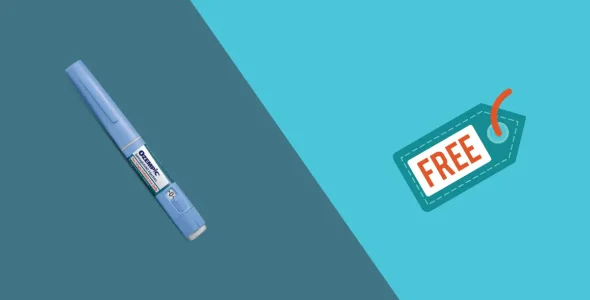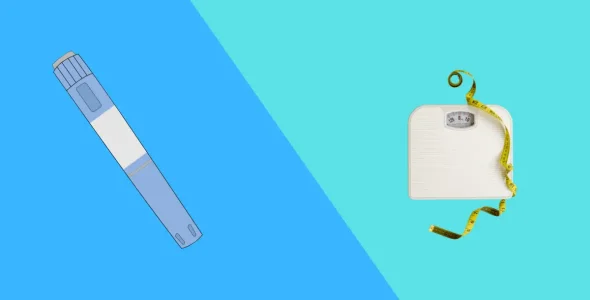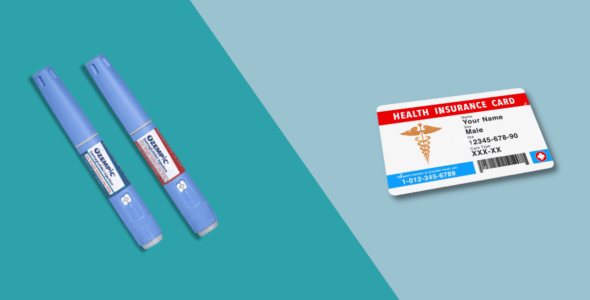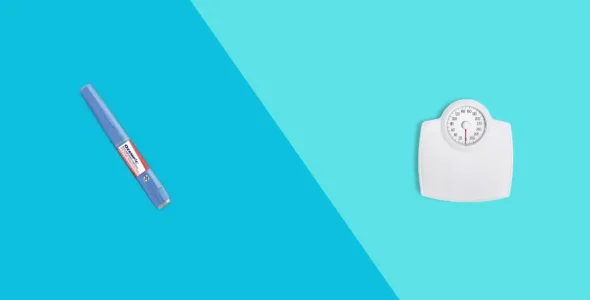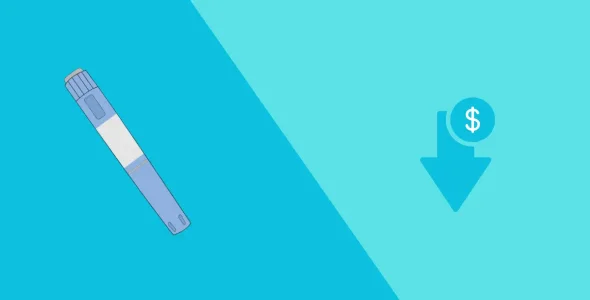What is Ozempic? The Ultimate Guide
Ozempic (semaglutide) is an FDA-approved injectable medication for people with type 2 diabetes that also promotes significant weight loss by mimicking a natural appetite-regulating hormone.
Key highlights
- Ozempic is a once weekly injectable GLP-1 medication that contains semaglutide as an active ingredient.
- The medication works by mimicking the action of the naturally occurring GLP-1 hormone, suppressing appetite, promoting satiety, and enhancing insulin release.
- Ozempic is FDA-approved for managing type 2 diabetes in adults and reducing the risk of cardiovascular diseases, worsening kidney disease, or death in patients with chronic kidney disease.
- Healthcare professionals prescribe Ozempic as an off-label medication for chronic weight management in obese and overweight patients.
- It is recommended to combine Ozempic with certain lifestyle modifications such as a balanced diet and increased physical activity.
According to the International Diabetes Federation, every 1 in 9 individuals has diabetes. About 90% of these patients have type 2 diabetes, and over 4 in 10 are unaware of their health condition. GLP-1 medications, including Ozempic, have shown promising results in the management of diabetes and obesity.
Ozempic is a once-weekly injectable medication that contains semaglutide as its active ingredient. Semaglutide acts as a GLP-1 receptor agonist. Ozempic is effective in managing type 2 diabetes and reducing cardiovascular risk. The medication is used off-label for weight management.
This article provides a comprehensive overview of what Ozempic is, how it works, its benefits for type 2 diabetes (and off-label weight loss), potential side effects, who it’s for, and other crucial information for US patients.
What is Ozempic?
Ozempic is a GLP-1 prescription medication, which means you need to get a valid prescription from a licensed healthcare provider to use the medication.
- Active ingredient: Ozempic contains semaglutide as an active ingredient. Semaglutide is a GLP-1 receptor agonist that occupies GLP-1 receptors and mimics the action of human glucagon-like peptide-1 hormone.
- FDA-approved use: Ozempic is FDA-approved for improving blood sugar in type 2 diabetes, reducing the risk of heart diseases, worsening kidney disease, end-stage kidney disease, and death in patients with chronic kidney disease and type 2 diabetes.
- Off-label use: The medication is used off-label for weight management. The FDA has not approved it for this purpose. Wegovy is an FDA-approved medication for weight loss that has the same active ingredient but has a higher dosage than Ozempic.
- Manufacturer: Ozempic is manufactured by Novo Nordisk. The company holds the patent for Ozempic. There is no generic version of Ozempic on the market.
Ozempic belongs to a class of drugs known as glucagon-like peptide-1 (GLP-1) receptor agonists that contain semaglutide. Wegovy and Rybelsus also have the same class.
Wegovy is also an injectable GLP-1 medication with the same active ingredient and mechanism of action as Ozempic. However, the medication is primarily FDA-approved for weight management and reducing the risk of cardiovascular events. It has a higher dosage than Ozempic. Rybelsus is available as oral tablets that are taken daily.
How does Ozempic work?
The active ingredient of Ozempic, semaglutide, has 94% structural similarity to the human glucagon-like peptide-1 hormone. Ozempic works in the following ways:
- The medication mimics the natural GLP-1 hormone in the body by occupying GLP-1 receptors in the brain. The GLP-1 hormone regulates appetite after food intake. When semaglutide occupies its receptors, it gives you a feeling of fullness and reduces appetite.
- Similar to the GLP-1 hormone, the medication stimulates insulin release from the pancreas when blood sugar is high.
- Ozempic reduces glucagon secretion from the alpha cells of the pancreas. Glucagon increases blood sugar levels. Its inhibition lowers blood glucose levels.
- The medication slows down gastric emptying, which means food moves from your stomach to the intestine at a slower rate, giving you a feeling of fullness for a longer time and you experience fewer hunger cravings.
- Ozempic affects the lateral hypothalamus, also known as the hunger control centre of the brain, to suppress appetite and promote satiety.
Key benefits
- The medication lowers hemoglobin A1c levels and improves blood sugar control.
- The same mechanism that promotes blood sugar control also contributes to weight loss in obese and overweight patients.
- Ozempic also improves the lipid profile and reduces the risk of heart and blood vessel-related diseases.
In a clinical study, Ozempic reduced HbA1c by 1.38%, fasting blood sugar levels by 56.53 mg/dl and body weight by 6.03 kg. There were significant improvements in systolic blood pressure, LDL, total HDL, non-HDL cholesterol, and triglyceride levels. These results reflect that Ozempic is effective in promoting blood sugar control, reducing the risk of heart and blood vessel diseases in patients with type 2 diabetes, and weight loss.
What is Ozempic used for?
When combined with a low-calorie diet, a healthy lifestyle, and increased physical activity, Ozempic is FDA-approved in adults with type 2 diabetes for the following purposes:
- To improve blood sugar control.
- To reduce the risk of major cardiovascular events (heart attack, stroke, or death) in adults with type 2 diabetes and established heart disease.
- To reduce the risk of kidney function decline, kidney failure or end-stage renal disease, and cardiovascular death in adults with both type 2 diabetes and chronic kidney disease.
Ozempic for weight loss (off-label)
Ozempic is not approved for weight loss by the U.S. Food and Drug Administration (FDA). However, the medication often leads to weight reduction as a result of the glucose-lowering effect. Healthcare professionals prescribe it off-label for weight management.
The FDA has approved semaglutide under the brand name Wegovy for weight management in patients with obesity and overweight with at least one weight-related health problem. The medication has a higher dosage than Ozempic.
Your doctor may prescribe Ozempic off-label if you are allergic to any ingredient of Wegovy or unable to tolerate a higher dosage of Wegovy. The medication is started at a low dose and escalated gradually.
A retrospective cohort study was conducted to evaluate the effectiveness of Ozempic (0.5 mg and 1 mg) in patients with type 2 diabetes over 12 months. After 1 year, the mean reduction in HbA1c levels was -2.1%. Patients showed a mean weight reduction of 6.19 kg. Moreover, there was a significant reduction in body mass index, total cholesterol levels, fasting blood sugar levels, low-density lipoproteins (LDL), and triglyceride levels.
However, it is essential to implement lifestyle changes and dietary modifications along with Ozempic injections. In a clinical trial, patients regained 8% of their body weight after 48 weeks of stopping the medication.
Who is Ozempic for?
According to FDA-approved indications, the following patients are the right candidates for Ozempic:
- Adults with type 2 diabetes
- Those who are at risk of developing cardiovascular diseases, such as heart disease, hypertension, and stroke or have an established heart or blood vessel disease, along with type 2 diabetes
- Patients with chronic kidney disease and type 2 diabetes (to prevent worsening kidney disease or kidney failure)
For off-label usage, Ozempic has the same indications as Wegovy. The patient must be obese (have a BMI of 30 or more) or overweight (BMI of 27 or more) with at least one disease that occurs due to increased body weight, such as high cholesterol levels, high blood pressure, heart disease, and non-alcoholic fatty liver disease. Your healthcare professional will decide if the medication is right for you.
Dosage and administration
Standard dosing
The typical starting dose of Ozempic is 0.25 mg once weekly. The dosage is titrated gradually every 4 weeks to reach the target blood sugar control. However, the maintenance dosage depends on the patient’s response and tolerability to the medication.
Remember that dosing schedules are general guidelines; consult your healthcare provider before starting the medication or adjusting the dosage. They will thoroughly assess your condition and prescribe the right dosage accordingly.
Starting dose
The Ozempic dosage starts at 0.25 mg once weekly for the first 4 weeks.
Titration phase
Every 4 weeks, your doctor will assess your condition, your body’s response and tolerability to the medication and escalate the dosage accordingly. The general titration schedule for Ozempic is as follows:
- Weeks 1-4: 0.25 mg once weekly
- Weeks 5-8: 0.5 mg once weekly
- Weeks 9-12: 1 mg once weekly, if your body can tolerate the previous dose.
- Weeks 13-16 and onwards: If further glycemic control is required, your prescriber will escalate the dosage to 2 mg once weekly.
Maintenance dose
1 mg once weekly is usually the maintenance dose of Ozempic.
Maximum dose
2 mg once weekly is the maximum dosage of Ozempic.
How to inject
Ozempic is injected subcutaneously (under the skin) just above your muscles, in the abdomen, upper thighs, and arms. The medication is administered once weekly at any time of day, with or without meals.
Before you start, it’s important to make sure the medication inside your Ozempic pen is clear, colorless, and free of any particles. If it looks cloudy, hazy or discolored, do not use it.
Ozempic is administered with the help of a pre-filled multi-dose pen. Always use a new, sterile needle for each injection to reduce the risk of infection and ensure proper dosage delivery.
Follow these step-by-step instructions to inject Ozempic:
- Wash your hands thoroughly with soap and warm water. This helps prevent the introduction of bacteria into your skin while injecting the medication.
- Attach a new needle to the Ozempic pen. Remove the protective seal from the needle, twist it onto the pen tightly, and remove both the outer and inner caps.
- Choose your injection site. Always inject at a new injection site each week to reduce the risk of skin infections. You can administer the medication into the front of your thighs, your abdomen (at least 2 inches away from the belly button), or the upper arm.
- Clean the injection area with an alcohol swab and let it dry completely. This reduces the chance of skin infection.
- Turn the dose selector on your Ozempic pen to set the prescribed dose. Double-check the number to ensure it matches what your healthcare provider has recommended.
- Pinch the skin slightly and insert the needle into your skin at a 90-degree angle.
- Press and hold the dose button until the dose counter shows “0.” Once it does, continue holding the button and keep the needle in your skin for at least 6 seconds to ensure the full dose is delivered.
- Withdraw the needle gently and apply light pressure to the site with a clean cotton swab if needed (do not rub your skin).
- Dispose of the used needle in a sharps disposal container. Never reuse or share needles, even with close family members.
- Put the cap back on the Ozempic pen and store it in the refrigerator (not the freezer) or as directed by your pharmacist or healthcare provider.
What to do if you miss a dose of Ozempic?
If you have missed a dose of Ozempic, take the medication as soon as you remember, within 5 days of the previously scheduled date. If more than 5 days have passed, skip the dosage and take the next dosage on its scheduled date. If you miss 2 or more doses, consult your doctor for a dose adjustment.
Benefits of Ozempic
Ozempic provides a significant reduction in HbA1c levels and promotes blood sugar control in patients with type 2 diabetes.
A 40-week SUSTAIN FORTE clinical trial was carried out at 125 outpatient centers across 10 countries. The trial included 961 adults with type 2 diabetes (the diabetes was not adequately controlled using metformin, with or without a sulfonylurea). Participants were randomly divided into two groups: one received 2.0 mg and the other 1.0 mg of semaglutide once per week.
The trial evaluated how effective semaglutide was in reducing HbA1c levels and body weight. Findings revealed that the 2.0 mg dose lowered HbA1c by 2.2%, while the 1.0 mg dose led to a 1.9% reduction. Both groups also experienced meaningful weight loss: those on 2.0 mg lost an average of 6.9 kg, while those on 1.0 mg lost around 6.0 kg.
The medication reduces the risk of cardiovascular events such as heart attack or myocardial infarction, stroke, and hypercholesterolemia in at-risk individuals.
A clinical study found that 32 weeks of semaglutide treatment led to a 1.38% drop in HbA1c, a 56.53 mg/dL reduction in fasting blood glucose, and an average weight loss of 6.03 kg. The treatment also resulted in significant improvements in blood pressure, LDL and HDL cholesterol levels, and triglycerides, highlighting its broad metabolic benefits.
Ozempic slows the progression of kidney disease and reduces the risk of death and kidney failure in patients with chronic kidney disease.
In a research study, patients with type 2 diabetes and kidney disease were given either semaglutide (1 mg weekly) or a placebo. After about 3.4 years, those who took semaglutide had a 24% lower risk of serious kidney problems or death from kidney disease, an 18% lower risk of cardiovascular diseases, and a 20% lower risk of death from any cause. They also had fewer heart-related deaths and slower kidney decline. Overall, semaglutide reduces the risk of serious health problems related to the kidneys and the cardiovascular system.
The same mechanism that promotes blood sugar control in type 2 diabetes patients also contributes to weight loss. However, the medication is not approved by the FDA for this purpose.
Semaglutide has proven to be effective in managing type 2 diabetes and promoting weight loss. In a clinical study, patients with type 2 diabetes who received 0.5 mg and 1 mg of semaglutide (Ozempic) once a week lost an average of 6.19 kg of body weight after 12 months, and their HbA1c levels reduced by 2.1%. A significant improvement in lipid profile was also noticed.
Ozempic is administered once weekly, which is convenient for most patients.
Potential side effects
Like other GLP-1 medications, Ozempic also has potential side effects. These side effects are usually less common at lower doses and may be noticeable at higher doses. Whenever you experience these side effects, discuss them with your healthcare provider. They will adjust the dosage according to your body’s response and the severity of side effects. If the side effects are intolerable, they may switch to a different medication.
Very common side effects (≥10% of users)
The most common side effects of Ozempic are nausea, diarrhea, vomiting, and constipation.
In a clinical study, the incidence of these common side effects in semaglutide (Ozempic) users was 74.2%. However, they were transient and resolved without any treatment or changes in dosage.
- Nausea: In the same study, 44.2% of patients who used semaglutide experienced nausea. If you feel nauseous during Ozempic treatment, avoid oily, greasy, and fatty foods.
- Diarrhea: The incidence of diarrhea was 31.5% in semaglutide users. Eating in small portions, staying adequately hydrated, and correcting electrolyte imbalance help manage diarrhea caused by Ozempic.
- Vomiting: 24.8% of semaglutide users had vomiting in the same semaglutide study. Symptomatic management is helpful for vomiting.
- Constipation: 23.4% of semaglutide users experienced constipation. To prevent constipation, add dietary fibers to your diet and drink plenty of water.
Common side effects (1-10%)
Common side effects of Ozempic are:
- Abdominal pain
- Gastrointestinal problems
- Decreased appetite
Less common side effects
Less common side effects of the medication are:
- Heartburn
- Excessive burping
- Bloating
- Severe stomach ache
- Gastritis
- Dizziness
- Fatigue
- Hair loss
A few Ozempic users experience facial fat loss while on Ozempic treatment, which is termed as “Ozempic face”. However, these side effects are rare as some people experience them while others do not.
Similarly, Ozempic personality is a set of personality and behavioural changes that Ozempic users experience. Suicidal ideation is also another side effect of the medication. However, these side effects are less common and still under FDA review.
Considering the possible side effects of Ozempic, a World Health Organization (WHO) analysis identified a potential link between semaglutide use and suicidal thoughts. Reports of such ideation appeared to be more frequent with semaglutide compared to other weight-loss and diabetes medications like metformin, dapagliflozin, and orlistat. This trend was especially noticeable in people with existing mental health conditions or those taking antidepressants or anti-anxiety medications.
Rare and serious side effects
Rare and serious side effects of Ozempic are:
- Pancreatitis: If you experience abdominal pain that radiates to the back, fever, nausea, and vomiting, call your doctor immediately and discontinue the use of Ozempic.
- Changes in vision: Ozempic can cause changes in vision and exacerbate diabetic retinopathy.
- Low blood sugar: You can experience hypoglycemia with Ozempic, especially when you use it with other diabetes medications such as insulin or sulfonylureas. Signs of low blood sugar are dizziness, anxiety, blurry vision, confusion, drowsiness, hunger, slurred speech, headache, feeling jittery, weakness, and rapid heartbeat. It can also lead to coma. Visit a nearby healthcare facility immediately to receive emergency care for this condition.
- Kidney problems, such as acute kidney injury, can occur due to dehydration caused by diarrhea and vomiting. If vomiting or diarrhea persists, immediately visit your healthcare professional.
- Severe stomach problems and gastritis may occur while taking Ozempic.
- Serious allergic reactions: Allergic reactions may occur with Ozempic. Symptoms of an allergic reaction are a swollen face, lips, tongue, and throat, body rash, itching, dizziness, increased heart rate, and difficulty breathing and swallowing.
- Gallbladder problems, such as gallstones, have also been reported in patients using Ozempic. If you get any symptoms of gall bladder problems, such as pain in the upper abdomen, yellowing of eyes and skin, clay-colored stools, and fever, inform your healthcare provider right away.
- Potential risk of thyroid tumors
- The medication can cause ileus (stomach paralysis/intestinal blockage) as it slows down the rate of stomach emptying.
- Ozmepic may increase the risk of pulmonary aspiration (food or liquid getting into your lungs) during anesthesia and sedation. This is a life-threatening condition. Inform your doctor if you plan to have any surgery or procedure that requires anesthesia or sedation.
Who should not take Ozempic?
Ozempic is contraindicated for the following patients:
- Those who are allergic to semaglutide or any of the ingredients.
- Patients with a personal or family history of medullary thyroid carcinoma (MTC).
- Patients with a history of Multiple Endocrine Neoplasia syndrome type 2 (MEN 2)
Ozempic has a boxed warning for patients with a history of medullary thyroid carcinoma and MEN 2 syndrome, as the medication increased the risk of these carcinomas in Rodent studies.
Moreover, before starting your treatment with Ozempic, inform your healthcare provider:
- If you have a history of pancreatitis (inflammation of the pancreas)
- You have diabetic retinopathy
- If you have any kind of kidney problems
- You have a severe gastrointestinal disease.
- You are pregnant, a breastfeeding mother, or planning to conceive. Ozempic is not safe for your unborn baby. Stop taking the medication 2 months before you try to conceive.
- Inform your healthcare professional if you are planning any surgery that requires anesthesia or sedation.
- Tell your doctor about your current medications, including prescription medication, supplements, herbal medications, vitamins, insulin or sulfonylureas, and antidepressants.
Ozempic vs. other medications
Here is a comparison of Ozempic with other medications:
Ozempic vs. Trulicity
Trulicity is a once-weekly injectable GLP-1 receptor agonist with dulaglutide as an active ingredient. Trulicity is indicated for managing type 2 diabetes and reducing the risk of heart disease in both adults and children aged 10 or older.
In a SUSTAIN 7 trial, Ozempic showed greater efficacy in lowering glycated hemoglobin levels and promoting weight loss than Trulicity. Mean reduction in HbA1c was 1.8% and 1.4% for Ozempic and Trulicity, respectively, after 40 weeks. Moreover, Ozempic led to a weight loss of 10-14 lbs compared to 5-7 lbs with Trulicity.
| Ozempic | Trulicity | |
|---|---|---|
| Active Ingredient | Semaglutide | Dulaglutide |
| Form | Injectable solution | Injectable solution |
| Dosage | 0.25 mg, 0.5 mg, 1 mg, and 2 mg | 0.75 mg, 1.5 mg, 3 mg, and 4.5 mg |
| Frequency of Use | Once weekly injection | Once weekly injection |
| FDA Approval | Type 2 diabetes, cardiovascular risk reduction, lowering the risk of end stage kidney disease in adults | Type 2 diabetes and cardiovascular risk reduction in children aged 10 or more and adults |
| Effectiveness for HbA1c Reduction | May lower HbA1c more (up to 1.8%) | May lower HbA1c less (up to 1.4%) |
| Effectiveness for Weight Loss | More effective for weight loss (up to 15% of body weight) | Moderate weight loss (3-9%) |
| Kidney Health Benefits | Proven to reduce the risk of kidney disease-related events | No studies yet on kidney-related benefits |
| Maximum Dose | 2 mg once weekly | 4.5 mg once weekly |
| List price (Without Insurance) | $997.58 per month (without insurance) | $987.19 per month |
| Heart Disease Risk Reduction | Reduces major cardiovascular events by 26% in patients with cardiovascular disease | Reduces major cardiovascular events by 12% in patients with cardiovascular risk |
Ozempic vs. Rybelsus
Rybelsus is also a brand-name medication containing semaglutide with the same mechanism of action as Ozempic. However, Rybelsus comes in the form of oral tablets, which are taken once daily. The medication is suitable for individuals who prefer oral medication over injectable options.
| Ozempic | Rybelsus | |
|---|---|---|
| Form | Injectable solution | Oral tablet |
| Active ingredient | Semaglutide | Semaglutide |
| Dosage | Available in 0.25 mg, 0.5 mg, 1 mg, and 2 mg | Available in 3 mg, 7 mg, and 14 mg |
| FDA Approval | Yes, for type 2 diabetes, cardiovascular risk reduction, and to lower the risk of worsening kidney disease | Yes, for type 2 diabetes only |
| Frequency of Use | Once weekly injection | Once daily tablet |
| Absorption | Over 80% absorption (injected) | Less than 1% absorption (oral) |
| Cardiovascular Benefits | Approved to lower the risk of cardiovascular events | Currently under study for cardiovascular benefits |
| Kidney Benefits | Proven to reduce the risk of kidney disease-related events | No studies yet on kidney-related benefits |
| Weight Loss | Weight loss of about 6.5 kg (real-world data) | Similar weight loss of about 5.9 kg (real-world data) |
| Cost | $997.58 per month (without insurance) | $997.58/package (without insurance) |
| Additional Benefits | Proven cardiovascular and kidney-related benefits in certain populations | Studies ongoing for cardiovascular benefits |
Ozempic vs. Victoza
Victoza is a brand-name drug containing liraglutide. Liraglutide is also a GLP-1 receptor agonist like semaglutide. Both medications have similar mechanisms of action, and their injections are administered subcutaneously.
| Ozempic | Victoza | |
|---|---|---|
| Active Ingredient | Semaglutide | Liraglutide |
| Form | Injectable solution | Injectable solution |
| Dosage | Available in 0.25 mg, 0.5 mg, 1 mg, and 2 mg | Available in 0.6 mg, 1.2 mg, and 1.8 mg |
| Frequency of Use | Once weekly injection | Once daily injection |
| Mechanism of Action | GLP-1 receptor agonist (stimulates insulin secretion and reduces glucagon release) | GLP-1 receptor agonist (stimulates insulin secretion and reduces glucagon release) |
| Approved Uses | Type 2 diabetes, cardiovascular risk reduction, lowering the risk of end stage kidney disease in adults | Type 2 diabetes in children aged 10 or more and adults, cardiovascular risk reduction |
| Kidney Benefits | Proven to reduce the risk of kidney disease-related events | No studies yet on kidney-related benefits |
| Cost (Without Insurance) | $997.58 per month (without insurance) | $543.51 for 2 pen package (0.6 and 1.2 mg), $815.27 for 3 pen package (1.8 mg) |
| Maximum Dose | 2 mg once weekly | 1.8 mg once daily |
Ozempic vs. Wegovy
Wegovy is a brand-name medication containing the same active ingredient, semaglutide, as Ozempic. The mechanism of action of both medications is the same. However, Wegovy is approved by the FDA specifically for chronic weight management in obese and overweight patients who have at least one weight-related health problem.
In a cohort study, 77 patients received higher doses of semaglutide 1.7 mg and 2.4 mg (maximum dose of Wegovy), and 98 patients received lower doses of semaglutide 0.25 mg, 0.5 mg, and 1 mg (typical doses of Ozempic). After 3 months, participants who received higher doses of semaglutide lost 6.9% of body weight, while those receiving lower doses lost 5.1% of body weight. At 6 months, the weight loss was 12.1% and 9.2% with higher and lower doses, respectively. This study suggests that Wegovy is more effective for weight management due to its higher dosage compared to lower doses of Ozempic.
Similar to Ozempic, Wegovy is also administered once weekly.
| Ozempic | Wegovy | |
|---|---|---|
| Primary Use | Type 2 diabetes management | Weight loss |
| Active Ingredient | Semaglutide | Semaglutide |
| Dose | 0.25 mg, 0.5 mg, 1 mg, 2 mg (once a week) | 0.25 mg, 0.5 mg, 1 mg, 1.7 mg, 2.4 mg (once a week) |
| Dosing schedules | Weeks 1-4: 0.25 mg once weekly Weeks 5-8: 0.5 mg once weekly Weeks 9-12: 1 mg once weekly, if you can tolerate the previous dose. Weeks 13-16 and onwards: If further glycemic control is required, your healthcare provider will increase the dosage to 2 mg once weekly. | Weeks 1-4: 0.25 mg once weekly Weeks 5-8: 0.5 mg once weekly Weeks 9-12: 1 mg once weekly, if you tolerate the previous dosage. Weeks 13-16: If required, your prescriber will increase the dosage to 1.7 mg once weekly. Weeks 17-21: If tolerated, the dosage will be increased to 2.4 mg once weekly. |
| Indication | Diabetes and cardiovascular and worsening kidney disease risk reduction, used off label for weight ma | Obesity management and weight loss |
| Mechanism of Action | Improves blood sugar control, reduces heart risk | Helps control appetite and reduces body weight |
| FDA Approval | Yes, for type 2 diabetes, cardiovascular risk reduction, and to lower the risk of worsening kidney disease | Yes, for weight loss (in combination with a reduced-calorie diet and increased physical activity) |
| Maximum Dose | 2 mg per week | 2.4 mg per week |
| Weight Loss Benefit | Modest weight loss (varies by individual) | Significant weight loss (up to 15-20% body weight reduction) |
| Side Effects | Nausea, vomiting, diarrhea, risk of thyroid tumors | Nausea, vomiting, diarrhea, potential for thyroid tumors |
| Price | Generally lower (due to diabetes indication) | Higher, due to weight loss indication |
| Insurance coverage | Covered by Insurance for type 2 diabetes | Generally not covered by insurance for weight management |
Ozempic vs. Mounjaro
Mounjaro is a brand name for tirzepatide. The medication acts as a dual agonist at GLP-1 and GIP receptors simultaneously. Due to its dual mechanism of action, Mounjaro is more effective in type 2 diabetes management than Ozempic.
A phase 3 clinical trial compared the effectiveness of semaglutide (Ozempic) and tirzepatide (Mounjaro) over 40 weeks. Participants were randomly assigned to receive either tirzepatide (5 mg, 10 mg, or 15 mg once a week) or semaglutide (1 mg once a week). The study focused on changes in HbA1c levels and body weight over 40 weeks. The results showed that tirzepatide, at doses of 5 mg, 10 mg, and 15 mg, led to a mean HbA1c change of −2.01%, −2.24%, and −2.30%, respectively. In comparison, semaglutide produced a mean change of −1.86%. Overall, tirzepatide was found to be more effective than semaglutide across all doses.
| Ozempic | Mounjaro | |
|---|---|---|
| Active Ingredient | Semaglutide | Tirzepatide |
| FDA-Approved Use | To control blood sugar in adults with type 2 diabetes, along with diet and exercise. To reduce the risk of major cardiovascular problems such as heart attack, stroke, and death in adults with type 2 diabetes and heart disease. | Type 2 diabetes (glycemic control) |
| Mechanism of Action | GLP-1 receptor agonist (stimulates insulin secretion and reduces glucagon release) | Dual GLP-1 and GIP receptor agonist (improves insulin secretion and reduces glucagon release) |
| Dosage Form and Strengths | Injectable solution: 0.25 mg, 0.5 mg, 1 mg, 2 mg | Injectable solution: 2.5 mg, 5 mg, 7.5 mg, 10 mg, 12 mg, and 15 mg |
| Most Common Side Effects | Nausea, vomiting, abdominal pain, diarrhea, or constipation | Nausea, vomiting, diarrhea, decreased appetite, abdominal pain |
| Administration | Once weekly injection | Once weekly injection |
| Maximum Weekly Dose | 2 mg | 15 mg |
| Effectiveness for Reducing HbA1c | 1% to 1.5% reduction (depending on dose) | 1.5% to 2.4% reduction (depending on dose) |
| Effectiveness for Weight Loss | 5% to 12% weight loss (depending on dose) | 12% to 22% weight loss (depending on dose) |
| Cardiovascular Benefits | Proven cardiovascular benefits in certain populations | Not yet approved for cardiovascular benefit |
| Cost Without Insurance | $997.58 per month | $1,079.77 per month |
Ozempic vs. metformin
Metformin belongs to a class of biguanides. The medication is approved for blood sugar control in adults and children aged 10 or older. Compared to once-weekly injections of Ozempic, metformin is available in the form of extended-release and immediate-release tablets that are taken daily.
| Ozempic (Semaglutide) | Metformin | |
|---|---|---|
| Generic Available | No | Yes |
| Active Ingredient | Semaglutide | Metformin |
| Drug Class | GLP-1 Receptor Agonist | Biguanide |
| FDA Approval for Weight Loss | Type 2 diabetes, cardiovascular risk reduction, chronic kidney disease | Type 2 diabetes management in adults and children aged 10 or more |
| Forms | Subcutaneous injection (solution in prefilled pen) | Oral solution, IR tablet, ER tablet |
| Dosages | 0.25 mg, 0.5 mg, 1 mg, 2 mg | Oral solution: 500 mg/5 mL, IR tablets: 500 mg to 1,000 mg, ER tablets: 500 mg to 1,000 mg |
| Frequency of Use | Once weekly | IR: 1 to 3 times per day, ER: Once daily |
| Administration | Subcutaneous injection (stomach, upper arm, or thigh) | Oral (swallowed) |
| Cardiovascular Benefits | Proven cardiovascular benefits in people with heart disease | Modest cardiovascular benefits |
| FDA Approval for Weight Loss | Not approved for weight loss, but used off-label for weight reduction | Not approved for weight loss |
| Cost (Without Insurance) | $997.58 per month (without insurance) | Approximately $25 to $60 per month (depending on dosage) |
| Precautions | Not recommended for people with a history of thyroid cancer, MEN 2 syndrome, pancreas issues | Not recommended for people with kidney or liver problems, history of lactic acidosis |
Ozempic cost and insurance coverage
The list price of Ozempic is $997.58 for 28 days supply. However, most patients do not pay the same amount as the price is discounted by using different coupons and savings cards.
You may get the medication for $1,000 to $1,300 or more from pharmacies. According to GoodRx, the retail prices of Ozempic at different pharmacies are the following:
| Pharmacy | Retail Price |
|---|---|
| Walgreens | $995.00 |
| Walmart | $995.00 |
| CVS Pharmacy | $995.00 |
| Costco | $964.99 |
Novo Nordisk offers an Ozempic Savings Card for patients with commercial or private insurance that covers Ozempic. By using this card, you can get a 1-month, 2-month, and 3-month supply of Ozempic for as low as $25. The Ozempic savings card can be used for up to 48 months. You will need a valid prescription from a licensed healthcare professional to use this offer. Moreover, there are certain conditions to be eligible for this program, such as:
- You are a U.S. resident.
- You are 18 years of age or older.
- You are not enrolled in any state, federal, or government-funded program such as VA, DOD, Medigap, Medicare, Medicaid, TRICARE, or similar programs.
- You are using the medication for its FDA-approved indications.
- You must have a valid prescription for Ozempic from a licensed healthcare provider.
Insurance coverage
Insurance coverage for Ozempic varies among insurance companies depending on your health insurance plan, deductibles, and the preferred drug list in your insurance plan. Medicare and Medicaid may or may not cover Ozempic. If you have Medicare Part D coverage, you may be eligible to get Ozempic coverage for type 2 diabetes.
Medicaid coverage for Ozempic varies between states. It is recommended to check if your state’s Medicaid formulary has Ozempic as a preferred medication.
Private insurance plans such as Aetna, Blue Cross Blue Shield, and United Healthcare may or may not cover Ozempic, depending on your insurance plan. It is essential to note that insurance companies typically cover Ozempic only for its FDA-approved uses. If you use Ozempic as an off-label drug for weight management, insurance will typically not cover it.
Pharmacy coupon cards also help reduce the cost of the medication. Pharmacies like GoodRx, Singlecare, BuzzRx, WellRx, and Optum Perks offer online coupons that may save up to 27% of the total cost.
Here are potential cost-saving strategies for Ozempic:
- If you have private or commercial insurance, check your eligibility for Novo Nordisk’s Ozempic Savings card program.
- If you are enrolled in Medicaid or Medicare insurance plans, check the insurance formulary.
- If you are uninsured, try to use pharmacy coupon cards.
- Compare the prices of Ozempic at different pharmacies, and choose the most affordable and reliable pharmacy.
- If you cannot afford Ozempic, speak to your healthcare provider about lower-cost Ozempic alternatives.
Is Ozempic right for you?
Ozempic might be a suitable option for you if:
- You have type 2 diabetes and need better blood sugar control.
- You have type 2 diabetes and established heart or kidney disease.
- You are looking for a once-weekly injection.
- You are interested in the potential weight loss benefits of Ozempic, along with blood sugar control.
- You are aware of the potential side effects and risks.
- You have discussed your medical history and other medications with your doctor, and they have prescribed you the medication.
- You are aware of Ozempic costs and its accessibility.
Before starting Ozempic, have an open and honest conversation with your healthcare provider to determine if Ozempic is the right treatment option for you. They will assess your blood sugar levels, HbA1c, body weight, BMI, and vital stats before prescribing the medication.
Ozempic FAQs
Is Ozempic safe for non-diabetics?
Yes, Ozempic is safe for non-diabetics when used off-label. However, if you want to use medication for weight management solely, Wegovy is likely a better option. Wegovy is FDA-approved for weight management in obese and overweight patients with at least one weight-related health condition.
How fast does Ozempic work?
Ozempic starts to work immediately as soon as it is injected. It starts to suppress appetite and promote blood sugar control within 1-4 weeks after starting the medication. However, clinical studies suggest that weight changes are noticeable after 4 weeks; these effects become more significant after 5-8 weeks.
Does Ozempic cause muscle loss?
Yes, Ozempic can cause muscle loss. Always pair Ozempic therapy with a balanced diet that contains protein-rich foods to prevent muscle loss.
Why is Ozempic out of stock?
The manufacturer of Ozempic, Novo Nordisk, owns the patent for Ozempic. There is no generic version of the medication on the market, and other pharmaceutical companies can not manufacture it. Due to high demand for Ozempic, a single manufacturer, and manufacturing delays, Ozempic has experienced on-and-off shortages.
Conclusion: Understanding Ozempic and its role in type 2 diabetes management
Ozempic is an effective prescription medication for type 2 diabetes management and reducing the risk of heart and blood vessel disease. The medication can lower blood sugar levels by mimicking the action of the naturally occurring GLP-1 hormone, enhancing insulin release, and suppressing appetite.
Ozempic works effectively when paired with a balanced diet and increased physical activity. The same mechanisms that promote blood sugar control in individuals with diabetes also contribute to weight loss. The medication is used off-label for weight management; the FDA has not approved it for this purpose. If you experience any side effects with Ozempic, immediately consult your doctor. Get regular follow-ups for continuous care and monitoring.
Remember, Ozempic cannot be used without a valid prescription from a healthcare provider. Before starting any GLP-1 medication, consult a healthcare provider. Talk to your doctor today to see if Ozempic is right for you—or explore alternatives like Mounjaro.




